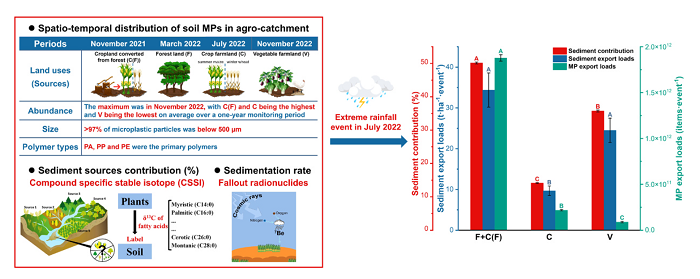Recently, the Research Team of Agricultural New Pollutants and Environmental Health Risk Prevention and Control at the Institute of Environment and Sustainable Development in Agriculture, Chinese Academy of Agricultural Sciences, revealed for the first time the "source-sink" relationship of soil microplastics in typical small intensive agricultural catchments under the background of land management policy transformation. The related findings have been published in the Journal of Hazardous Materials.

Intensive agricultural activities often lead to increased accumulation and erosion of soil microplastics. Under the influence of surface runoff and other factors, soil microplastics can enter water bodies, posing a threat to the safety of water ecosystems. Therefore, the impact of intensive land use on the spatio-temporal distribution and export loads of soil microplastics in agro-catchments is crucial for formulating targeted microplastic pollution prevention and control measures.
The study monitored the spatio-temporal occurrence characteristics of soil microplastics in a small intensive agricultural catchment in North China across one year. At the same time, the study innovatively combined compound-specific stable isotope (CSSI) sediment fingerprinting with 7Be tracer to quantitatively analyze the source contribution and export loads of sediments and microplastics during extreme rainfall events. The study suggests that forest land and cropland converted from forest are the primary sources of sediments, with microplastic export loads being significantly higher than those of farmland and vegetable farmland. It is essential to focus on managing newly reclaimed farmland after policy transformation. Measures such as improving fertilizer utilization and enhancing slope maintenance after heavy rainfall should be implemented to reduce the generation and migration of microplastics at the source, thus providing a scientific basis for the prevention and control of non-point source pollution in intensive agriculture.
This study was supported by the National Key Research and Development Program of China and the International Atomic Energy Agency Coordinated Research Project, among others.
Linkage: https://www.sciencedirect.com/science/article/pii/S0304389425002900#sec0005

